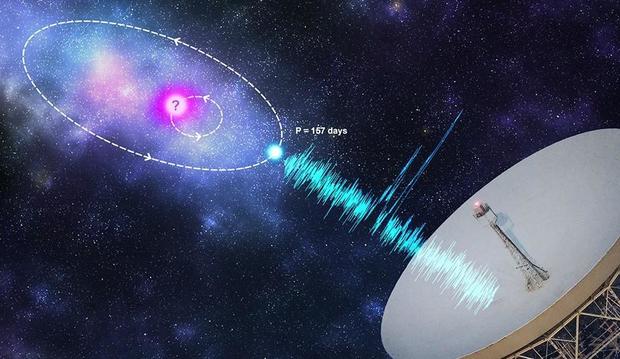Another mysterious deep space radio burst is sending signals to Earth every 157 days, study finds
Astronomers announced this weekend that they've detected a mysterious fast radio burst coming from a dwarf galaxy three billion light-years away. The burst — known as an FRB — appears to be transmitting signals that reach Earth in a repeating, 157-day pattern, the group said.
The discovery marks just the second time ever that scientists have identified an FRB that repeats in a pattern. In February, scientists revealed that an object 500 million light-years away appeared to be transmitting signals every 16 days.
FRBs are bursts of radio waves in space that last just a millisecond. Some have been traced back to their home galaxies, but astronomers have yet to figure out what causes them.
An international team led by University of Manchester astronomers at the Jordell Bank Observatory was able to track emissions from FRB 121102, which has been studied for years. Their study of the FRB was published Sunday in the journal Monthly Notices of the Royal Astronomical Society.
The recently detected FRB sends out bursts during a 90-day window, followed by 67 days of silence, in a loop that repeats every 157 days, the astronomers said. The FRB was first discovered in 2012 and was seen repeating in 2016 — but this study is the first to identify its pattern.
The discovery marks an important step in finding the origins of FRBs. The presence of a repeating pattern may indicate the bursts are linked to the orbit of a massive star, a neutron star or a black hole, the scientists said.
Another theory links the pattern to periodic wobbles in the rotational axis of a highly magnetized neutron star. But the lengthy precession period makes this theory unlikely.
"This is an exciting result as it is only the second system where we believe we see this modulation in burst activity," lead author Dr. Kaustubh Rajwade said in a news release. "Detecting a periodicity provides an important constraint on the origin of the bursts and the activity cycles could argue against a precessing neutron star."
This FRB pattern is significantly longer than its 16-day counterpart, indicating the potential range for these types of emissions.
"This exciting discovery highlights how little we know about the origin of FRBs," said Duncan Lorimer, who serves as Associate Dean for Research at West Virginia University and, along with PhD student Devansh Agarwal, helped develop the data analysis technique that led to the discovery. "Further observations of a larger number of FRBs will be needed in order to obtain a clearer picture about these periodic sources and elucidate their origin."
The signals have mystified scientists ever since the first FRB was found in 2007. Some have wondered if FRB's could be a message from aliens — and without more research, there's no way to know. Hundreds have been spotted, but only a handful have ever repeated themselves — and they appear to come from locations all over the universe.





